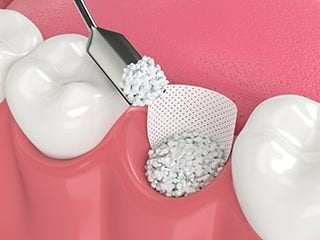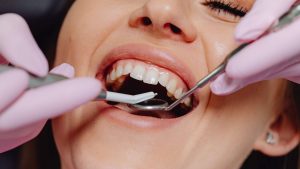Bone Grafting
The alveolar ridges are thickened ridges of bone on the upper and lower jaws. Teeth fit into sockets in these ridges, where they are held securely in place by periodontal ligaments. If the alveolar bone loses volume and density, that secure attachment is compromised. Bone grafting is a common surgical procedure which replaces and repairs damaged bone.
Bone loss in the jaw can have serious consequences for your dental health. Bone loss leads to loosening and eventual loss of teeth. Teeth shift, affecting your bite. Lack of bone density makes the placement of dental implants or implant-supported dentures impossible. Further, facial muscles and features lose structural support, causing a sunken appearance in the lips, cheeks, and chin.
 To prevent bone loss from affecting your quality of life, your dentist might recommend a bone graft. During this procedure, grafting material is implanted in the damaged area, where it serves as a platform for your own bone tissue to regenerate and restore bone volume and density.
There are several types of grafting material, and your dentist can help you choose the type of graft which will work best for you.
To prevent bone loss from affecting your quality of life, your dentist might recommend a bone graft. During this procedure, grafting material is implanted in the damaged area, where it serves as a platform for your own bone tissue to regenerate and restore bone volume and density.
There are several types of grafting material, and your dentist can help you choose the type of graft which will work best for you.
Conditions that Cause Bone Loss
- Resorption
- Periodontitis
- Trauma
- Bone Structure and Size
Bone Graft Procedure
 To prevent bone loss from affecting your quality of life, your dentist might recommend a bone graft. During this procedure, grafting material is implanted in the damaged area, where it serves as a platform for your own bone tissue to regenerate and restore bone volume and density.
There are several types of grafting material, and your dentist can help you choose the type of graft which will work best for you.
To prevent bone loss from affecting your quality of life, your dentist might recommend a bone graft. During this procedure, grafting material is implanted in the damaged area, where it serves as a platform for your own bone tissue to regenerate and restore bone volume and density.
There are several types of grafting material, and your dentist can help you choose the type of graft which will work best for you.
- Autografts: Bone tissue taken from elsewhere in your body
- Allografts: Screened and prepared bone material provided by a human tissue bank
- Xenografts: Screened and prepared bone provided by an animal tissue bank (typically cow bone)
- Alloplastic grafts: Synthetic grafting material manufactured with biocompatible mineral compounds
- Growth factors might be applied with the grafting material to stimulate cell growth
Please return to the home page to learn more about Dr. Mary Hand, our Fort Myers dentist.


